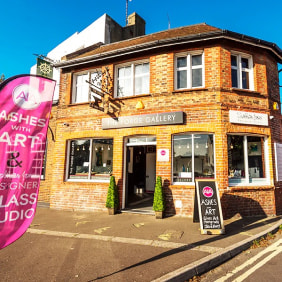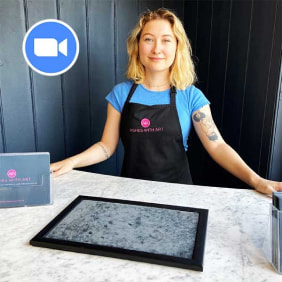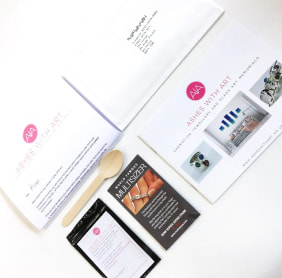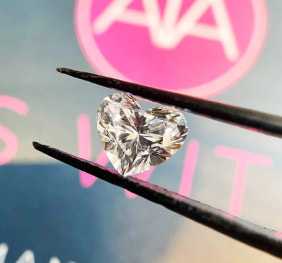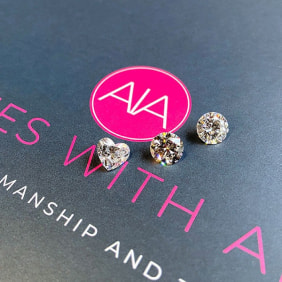Memorial Glass vs Diamonds: Which Is Right for You?
- ✓ Turning ashes into a diamond is possible but prohibitively expensive and often produces a yellow-hued stone with inclusions.
- ✓ Memorial glass is a simpler, far more cost-effective option and can be shaped/coloured for jewellery or keepsakes.
- ✓ For a heirloom look, many families choose hidden-chamber ashes jewellery paired with a lab-grown diamond.
There is a sense of beauty and intrigue in turning a loved one’s remains into a diamond. Diamonds are visually stunning and there is a sense of intrigue in how they are made. We can now replicate this process and speed up what would normally take millions of years. This means that a loved one’s ashes can be easily turned into a diamond and added to a piece of jewellery.
As you can probably imagine, the process of turning a loved one’s ashes into a diamond is prohibitively expensive. This is why glass gemstones are often recommended as a more accessible option. Turning ashes into decorative glass pieces can result in equally stunning jewellery for a fraction of the cost. In this guide, we’re going to take a deep dive into the process of turning ashes into diamonds and glass so you can make an informed choice about which one is right for you.
Memorial diamonds: an overview
We typically think of diamonds as being rare, expensive and precious. They are mined from the earth and formed millions of years ago. It’s purely chance that they came to be and were then discovered. This is why it’s even more miraculous that we can also replicate this process with human cremation remains.
By compacting the material and then subjecting this to extreme pressure and heat, we can turn ashes into a glittering diamond. This is the same process as creating a lab-grown diamond, but far more expensive. Structurally, the diamond has the exact same properties as a mined diamond.
Since it is so expensive, the resulting diamond is not worth the cost of creating it, so it’s not something that holds its value. The price of diamonds in general has fluctuated a lot in recent years due to the arrival of lab grown alternatives. This means that diamonds are not a good investment.
If you choose to turn a loved one’s ashes into a diamond, this is a symbolic action, since the resulting diamond will also be visually inferior to a mined or even a lab grown diamond.
Benefits of a cremation diamond
Diamonds have always held a special place for many people. It’s hugely symbolic to think of your loved one being transformed into something so stunning and rare.
Diamonds also make the perfect centre piece for a stunning piece of statement jewellery. This could include diamond stud earrings, a diamond solitaire ring or a pendant necklace. They could also be combined with other precious gemstones, such as the person’s birthstone, to make the piece even more special and unique.
Diamonds are also incredibly durable and will last beyond a lifetime. This could allow them to become the ideal keepsake and family heirloom that could be passed down through your family.
Downside to cremation diamonds
Perhaps the biggest drawback is the cost. Turning a loved one’s ashes into a diamond will cost more than a regular diamond of much better quality, so you are truly paying for the emotional attachment.
A diamond made from human remains will also be visually inferior to mined or lab grown diamonds. This is because of the type of material used to create the diamond. It will typically be a yellow hued diamond, with lots of inclusions, which can impact the quality of the shine and sparkle.
And finally, there is no going back or trying again if you are unhappy with the results. Once created, the diamond cannot be adjusted or optimised further, so if you have a very poor quality diamond, you’ll just have to make this the centrepiece of your jewellery anyway.
Memorial glass gemstones: an overview
A far simpler and cost-effective process would be to turn ashes into glass. This is a simple process that delivers beautiful results. The glass is heated to the point that it is molten, and then the ashes are rolled into the centre. The glass can be shaped into the desired form and then cooled and polished. Alternatively, glass gemstones can be made by layering ashes within fused glass, and then shaping.
The result is a beautiful gemstone made from glass, with the ashes suspended in the core. It’s also possible to add extra components like metallic fragments to create a subtle sparkle and shimmer.
While this isn’t on the same level of intrigue and beauty as a diamond, it can still be a beautiful choice for memorial jewellery. Glass gemstones are versatile and adaptable to a wide range of jewellery styles and can be personalised by choosing different colours and shapes.
You could also create a much larger glass keepsake, such as an ornament, a pebble or even an artwork. Since glass is so much more cost effective than diamonds, you can afford to create much larger pieces.
Benefits of glass gemstones
The price is often the main selling point for choosing glass over a diamond. You might like the idea of a diamond, but ultimately the cost is just too high.
Glass gemstones are far more sturdy and reliable than resin jewellery, so they can also become precious keepsakes that are passed down through the generations. There is also less of a fear that your gemstone might be targeted by thieves, as they will see that it is an inexpensive piece.
Glass can also be adapted to your style by choosing the colour and the finish. Some glass can be quite clear, which allows the ashes to be seen, suspended in place. You can also choose opaque colours, which sometimes keep the ashes concealed and more subtle, so only you will know that it is a memorial piece.
Downsides of glass gemstones
A glass gemstone isn’t as visually stunning as a diamond. While you could choose clear diamond shades, and you could have this cut in the same way as a diamond, it’s still just glass. If you’re looking for something with wow-factor, then a glass gemstone might disappoint.
How to choose the right one for you
It often comes down to a matter of budget. The two options are very different, so it’s important not to look at glass gemstones as a budget version of a diamond, as this will set you up for disappointment.
A diamond made from human remains is a beautiful and symbolic choice, but it’s important to remember the limitations of this method. If you’re expecting a visually stunning diamond, you might be disappointed. A far better choice would be to create a piece of hidden chamber jewellery with a lab grown diamond setting. This offers the best of both worlds.
If you aren’t too concerned with diamonds, then glass gemstone jewellery is a popular choice that will allow you to create a beautiful keepsake that allows you to remain connected to your loved one. Glass gemstones are inexpensive, and they can also be oversized to make keepsakes like pebbles and ornaments.
Take your time to think about what you really want in a piece of jewellery. For a family heirloom, it can be touching to turn your loved one’s remains into a diamond, as this will be a treasured piece of jewellery that can be passed down to future generations. The diamond might not retain its value, but this is a keepsake, not an investment.
Diamonds vs memorial glass: quick comparison
| Option | Benefits | Downsides |
|---|---|---|
| Cremation diamond | Symbolic; durable; heirloom-worthy; can be the centrepiece of jewellery | Very high cost; often yellow with inclusions; no post-creation optimisation |
| Memorial glass | Cost-effective; colours/shapes to suit; suitable for jewellery and keepsakes | Less “wow-factor” than diamonds; still glass even when cut like a diamond |

